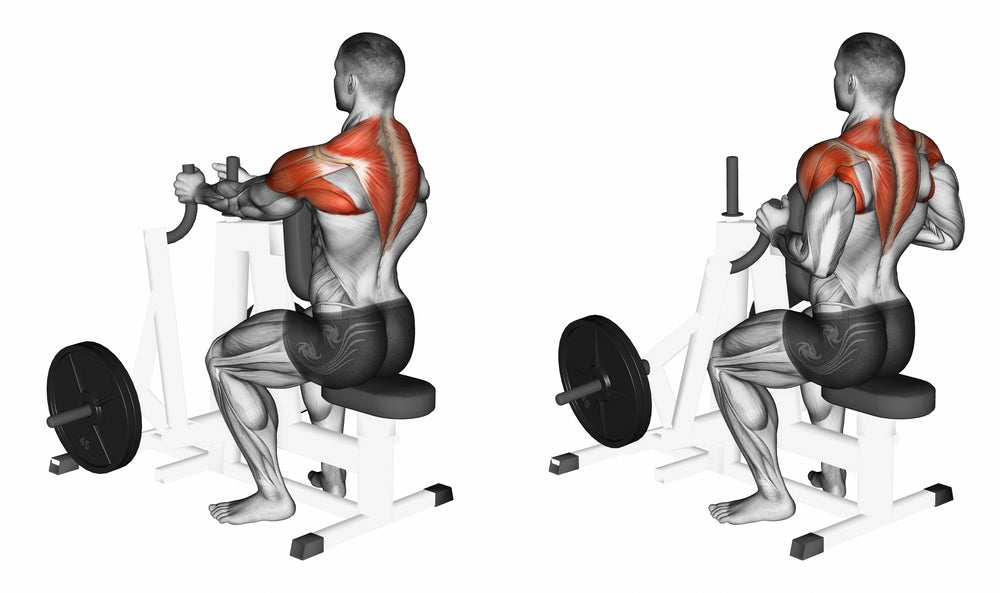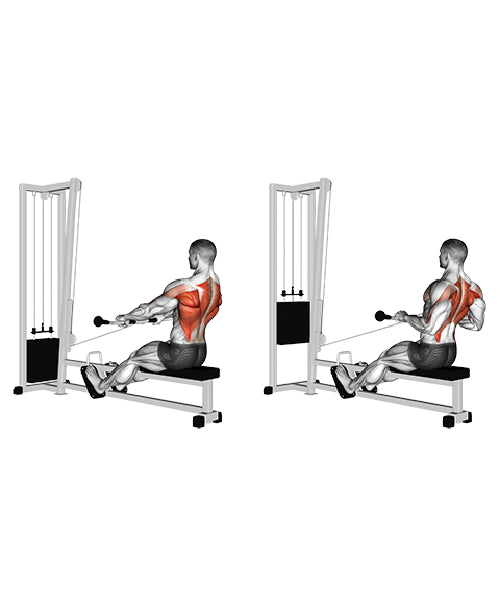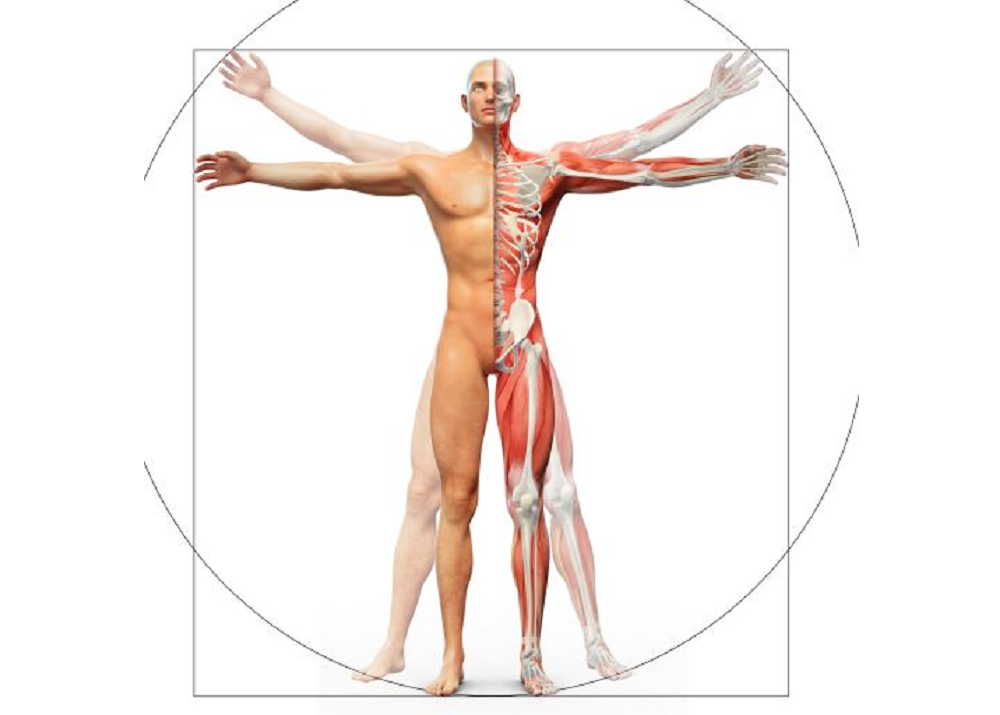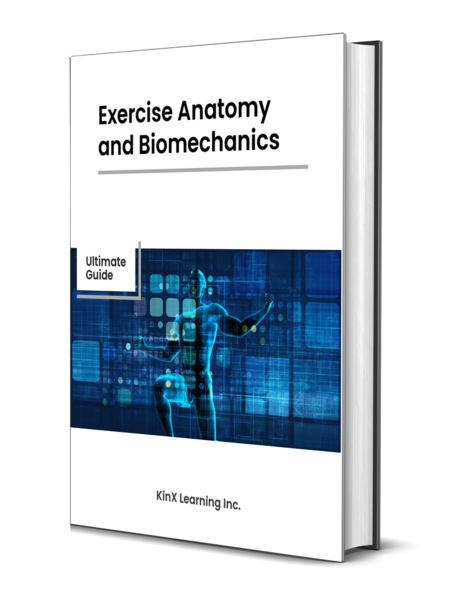Exercise Anatomy
Seated Row
The Seated Row is a key exercise for building a strong and well-defined back. Its seated position provides excellent lower back support, emphasizing mid-back muscles. This compound movement targets multiple muscle groups simultaneously, making it a time-efficient choice for those aiming to enhance back strength and achieve a sculpted physique. Incorporate the Seated Row into your routine for a powerful and effective back workout.

Major Muscles and Actions Involved
Variant 1: Neutral grip
During the Seated Row with a neutral grip, the primary joint action is shoulder adduction and extension, as the arms are pulled toward the body. This movement predominantly engages the muscles of the upper back, including the latissimus dorsi, rhomboids, and traps. Additionally, the rear deltoids, biceps, and forearm muscles contribute to the pulling motion. The neutral grip emphasizes the mid-back, promoting balanced muscle development and providing a unique variation to target specific areas of the back effectively.

Variant 2: Pronated grip variant
Variant 2: Pronated grip
During the Seated Row with a pronated grip, the primary joint actions involve shoulder adduction and extension as the arms are pulled toward the body. This variation places a greater emphasis on the latissimus dorsi, the broad muscles of the upper back. The rhomboids, traps, rear deltoids, biceps, and forearm muscles are also actively engaged in the pulling motion. The pronated grip, where palms face downward, targets the back muscles differently, promoting a well-rounded development of the upper back and enhancing overall strength and definition.
Exercise Execution
Body Position: Sit on the rowing machine with your feet firmly planted on the platform. Maintain a straight posture with your chest up, shoulders back, and back slightly leaning forward from the hips.
Grip: Reach forward and grasp the handles with a neutral grip, palms facing each other. Ensure your grip is comfortable and allows a full range of motion.
Movements: Begin the exercise by retracting your shoulder blades and pulling the handles toward your torso. Keep your elbows close to your sides throughout the movement. Aim to squeeze your shoulder blades together at the fully contracted position.
Controlled Release: Slowly extend your arms back to the starting position, maintaining control over the movement. Avoid fully straightening your arms to keep tension on the muscles.
Breathing: Inhale as you extend your arms, and exhale as you pull the handles towards you. Maintain a steady breathing pattern to support core stability.
Ensure a smooth, controlled motion throughout, focusing on engaging the muscles of the back. Adjust the seat and handle positions to suit your body proportions for optimal effectiveness and comfort.

Safety First
For the Seated Row, the most important safety consideration is maintaining proper posture to protect your lower back and shoulders from injury. Keep your back straight with a slight natural curve in your spine, and avoid rounding your shoulders or arching your back excessively. As you pull the handle toward your torso, focus on engaging your back muscles, particularly the lats and rhomboids, while keeping your core tight to stabilize your body. Avoid jerking the weight or using momentum, and make sure to pull with controlled movement. Additionally, avoid pulling the handle too far back, which can cause shoulder strain. Keep your feet firmly on the platform and ensure you maintain a neutral neck position to avoid stress on your upper body.

Sports Uses
The Seated Row is particularly beneficial for athletes involved in sports that demand strong and well-developed upper body muscles, especially the back. Athletes in sports such as rowing, swimming, and wrestling can benefit significantly from the Seated Row as it targets the muscles essential for powerful pulling movements. The exercise enhances overall back strength, endurance, and stability, contributing to improved performance in activities that heavily rely on upper body strength and coordination. Incorporating the Seated Row into training routines can be especially advantageous for athletes seeking to optimize their pulling strength and functional movement patterns.
Exercise Tips
- Proper Technique: Maintain a straight back and avoid excessive leaning during the Seated Row. Initiate the movement by retracting the shoulder blades and pulling with the back muscles rather than relying solely on arm strength.
- Full Range of Motion: Ensure a complete range of motion by fully extending your arms in the starting position and pulling the handles toward your torso with each repetition. This maximizes muscle engagement and benefits.
- Appropriate Weight Selection: Choose a weight that challenges your muscles without compromising form. Striking a balance ensures effective muscle recruitment and reduces the risk of injury. Adjust the weight as needed for different sets.
- Grip Variation: Experiment with different grips, such as pronated (palms facing down), neutral, or supinated (palms facing up), to target various muscles in the back. Each grip variation can offer unique benefits and prevent muscle imbalances.
- Controlled Breathing: Coordinate your breath with the movement. Inhale as you extend your arms, and exhale as you pull the handles toward your torso. Consistent breathing enhances stability and control throughout the exercise.
Seated Row vs the BENT-OVER DUMBBELL ROW
The seated row and bent-over dumbbell row are both effective exercises that target the muscles of the upper back, but they differ in terms of body position, equipment used, and the specific muscles emphasized. Here's a brief comparison:
1. Body Position:
- Seated Row: In this exercise, you sit on a bench or machine with your legs extended and pull a handle or cable toward your torso.
- Bent-Over Dumbbell Row: This exercise involves bending at the hips, keeping your back straight, and pulling dumbbells from a hanging position toward your hips.
2. Equipment:
- Seated Row: Typically performed using a cable machine with a seated row attachment or a specialized rowing machine.
- Bent-Over Dumbbell Row: Requires a pair of dumbbells and a bench or other surface for support.
3. Muscles Worked:
- Seated Row: Primarily targets the mid to upper back muscles, including the latissimus dorsi, rhomboids, and traps. It also engages the biceps to some extent.
- Bent-Over Dumbbell Row: Focuses on the lats, rhomboids, traps, and rear deltoids. It also involves the lower back muscles and requires core stabilization.
4. Range of Motion:
- Seated Row: Generally has a more controlled and guided range of motion, as it is performed on a machine.
- Bent-Over Dumbbell Row: Allows for a more natural range of motion, promoting greater muscle engagement for stabilization and control.
5. Stability and Balance:
- Seated Row: Provides more stability as you are seated and supported.
- Bent-Over Dumbbell Row: Requires better balance and engages the core for stabilization due to the bent-over position.
6. Versatility:
- Seated Row: Limited to the equipment available in the gym.
- Bent-Over Dumbbell Row: Can be performed with just a pair of dumbbells, making it more versatile and accessible.
Both exercises have their advantages, and the choice between them depends on individual preferences, fitness goals, and available equipment. Incorporating a variety of exercises into your workout routine can help target different muscle groups and enhance overall strength and development.

Want to Learn More?
Try our premium ebook, Exercise Anatomy and Biomechanics: Ultimate Guide.
Satisfaction guaranteed.
